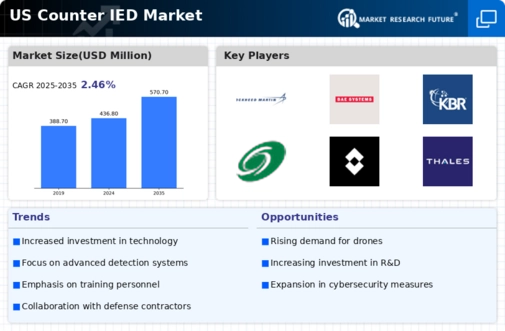Rising Security Concerns
The counter ied market is experiencing growth driven by escalating security concerns across various sectors. With the increasing frequency of threats, both domestic and international, there is a heightened demand for advanced countermeasures. Government agencies and private organizations are investing significantly in technologies that can detect and neutralize improvised explosive devices (IEDs). In 2025, the market is projected to reach approximately $10 billion, reflecting a compound annual growth rate (CAGR) of around 8%. This trend indicates that stakeholders are prioritizing safety and security, thereby propelling the counter ied market forward.
Increased Military Expenditure
The counter ied market is benefiting from increased military expenditure, particularly in the context of counter-terrorism operations. The U.S. military has recognized the persistent threat posed by IEDs and is allocating substantial resources to develop countermeasures. In 2025, military spending on counter IED technologies is projected to surpass $3 billion, reflecting a strategic focus on enhancing operational capabilities. This investment not only supports the development of advanced systems but also stimulates growth within the counter ied market, as defense contractors seek to provide innovative solutions to meet military needs.
Legislative Support and Funding
Legislative measures aimed at enhancing national security are playing a crucial role in the counter ied market. Increased funding from federal and state governments for counter-terrorism initiatives has led to the development of innovative technologies and training programs. In 2025, federal allocations for counter-terrorism efforts are expected to exceed $5 billion, which directly benefits the counter ied market. This financial support not only fosters research and development but also encourages collaboration among various stakeholders, including defense contractors and law enforcement agencies, thereby strengthening the overall market landscape.
Growing Public-Private Partnerships
The counter ied market is witnessing a rise in public-private partnerships aimed at enhancing security measures. Collaboration between government entities and private sector companies is fostering innovation and efficiency in developing counter IED solutions. These partnerships are essential for sharing resources, expertise, and technology, which can lead to more effective countermeasures. As of November 2025, it is estimated that such collaborations could account for nearly 30% of the market's growth. This trend suggests a collective effort to address the challenges posed by IEDs, ultimately strengthening the counter ied market.
Advancements in Detection Technologies
The counter ied market is significantly influenced by advancements in detection technologies. Innovations such as ground-penetrating radar, chemical sensors, and artificial intelligence are enhancing the capabilities of security personnel to identify potential threats. As of November 2025, the market for detection technologies is estimated to account for over 40% of the total counter ied market revenue. This growth is indicative of the increasing reliance on sophisticated tools to mitigate risks associated with IEDs. The integration of these technologies into existing security frameworks is likely to improve response times and overall effectiveness.























Leave a Comment